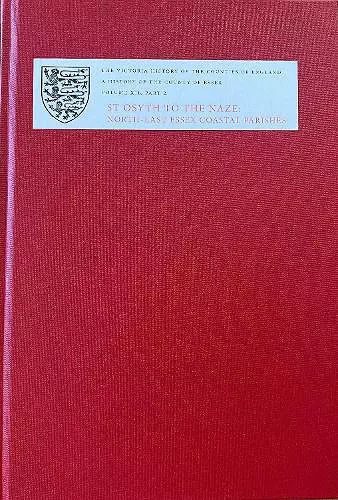A History of the County of Essex
XII: St Osyth to the Naze: North-East Essex Coastal Parishes. Part 2: The Soken: Kirby-le-Soken, Thorpe-le-Soken And Walton-le-Soken
Format:Hardback
Publisher:Victoria County History
Published:26th Jul '22
Currently unavailable, and unfortunately no date known when it will be back

This book explores the history of the Essex coastline in Tendring Hundred before seaside resorts emerged, detailing the economic influences of the sea and the significance of the Soken area.
A History of the County of Essex delves into the rich history of the Essex coastline, particularly focusing on the Tendring Hundred prior to the emergence of seaside resorts in the mid-19th century. This work serves as a companion volume to VCH Essex Volume XI, which covers the development of those resorts. The book provides an insightful analysis of how the coastal communities evolved economically, transitioning from agriculture and fishing to smuggling, all shaped by their proximity to the sea.
A significant portion of the narrative is dedicated to the exploration of the Soken, an area with unique legal jurisdiction and social organization. Originally owned by the Dean and Chapter of St Paul's Cathedral during the Middle Ages, the Soken later came under the control of various lay owners, including the Darcy family of St Osyth Priory and the Earls of Rochford. This historical context enriches the reader's understanding of the region's governance and social dynamics over the centuries.
The book also presents modern accounts of the large parishes of Kirby-le-Soken, Thorpe-le-Soken, and Walton-le-Soken, which were once part of a larger estate owned by St Paul's Cathedral before the Norman Conquest. Over time, these areas developed into distinct parishes and manors, each with coastlines along Hamford Water or the North Sea. The unique geological features of the region, such as the London Clay cliffs and the prominent Naze, highlight the area's significance both historically and environmentally, serving as a vital landmark for maritime navigation.
Sections for each parish carefully and expertly describe settlement, landholding and the agricultural economy. Combined, the books present a valuable picture of an area which John Hunter, the county's well-known landscape historian, described as 'virtually unstudied'. -- MEDIEVAL SETTLEMAN RESEARCH GROUP
Reviewing volume XI shortly after its publication in 2012 for The Local Historian, I concluded that the work was a first-class resource for historians and a fascinating reference work for a wider readership; and that it was meticulously researched and written in a detailed yet accessible manner. These observations apply equally to the work under review. -- Sean O'Dell * The Local Historian *
ISBN: 9781904356554
Dimensions: unknown
Weight: 1402g
256 pages